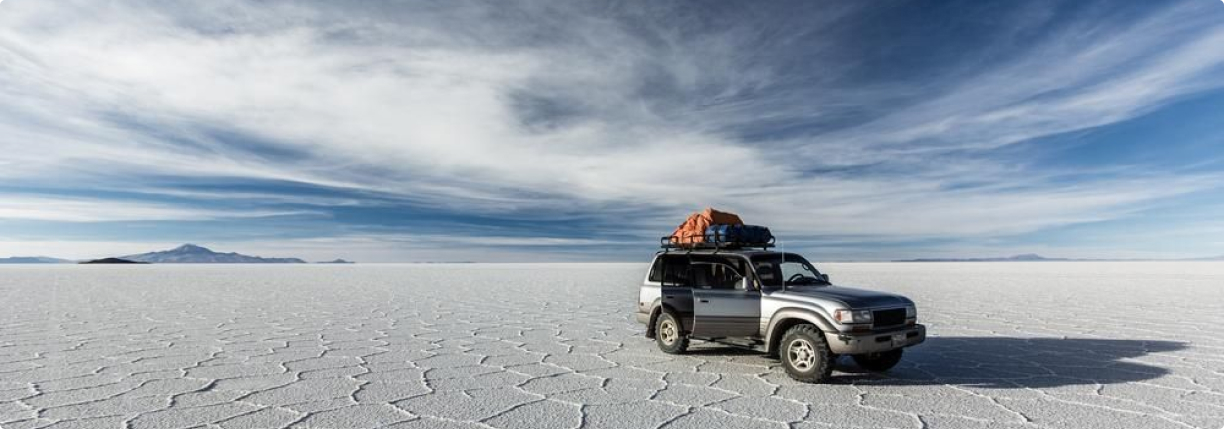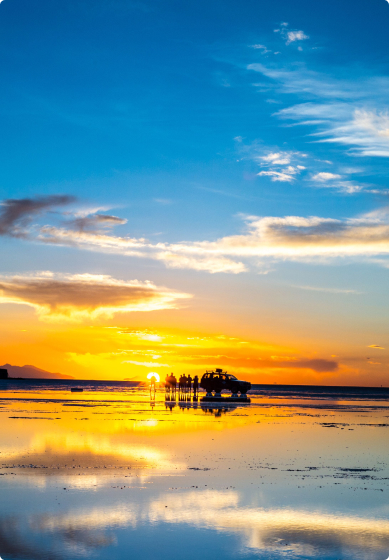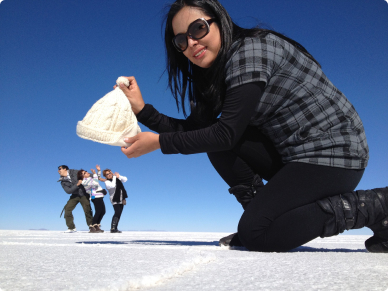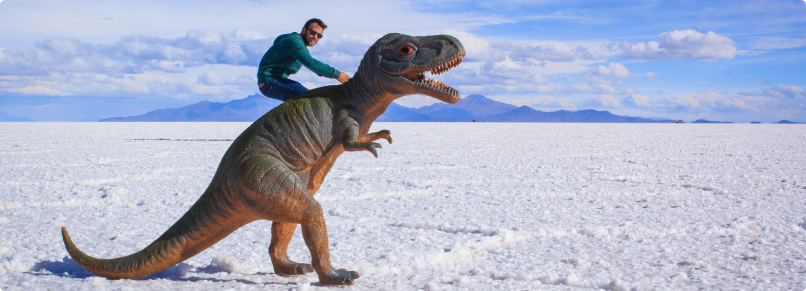Bolivia Salt Flats
Salar de Uyuni 2023 Complete Guide: Everything you need to know about the Salar de Uyuni Bolivia, from how to get there, the best time to go, and tips and advice based on years of experience visiting the Salar de Uyuni.
Salar de Uyuni Tours
1, 3 and 4 Day Tours available
All operators offer daily departures
Price: From $59 USD - Prices differ from operators
Click any link to go direct to that section or scroll down to read the whole guide

Covering 10,582 square kilometers (4,086 square miles, Salar de Uyuni has become one of the most popular attractions in South America).
Every year, thousands of visitors flock into Bolivia looking to discover the magical Salar de Uyuni. And it’s not just for the salt flats but for the other attractions nestled in Uyuni as well, such as the salt hotel, train graveyard, and much more! Because of this, many travelers find themselves asking the best way to get to Salar de Uyuni based on where they’re located. Read below to learn how to get there from various directions.
Overnight bed buses from La Paz usually take 8 hours and arrive in Uyuni early in the morning, allowing those on the bus to do a tour of the salar that day.
Bolivia Hop has been officially voted Bolivia’s best bus company for 3 years consecutively starting in 2016 and it is the best way to get to and from La Paz. However, unfortunately, we still do not operate from La Paz to Uyuni so it is recommended to travel with Todo Turismo. Despite being more expensive, they are significantly more comfortable and recently acquired new bed buses to ensure you arrive to the salt flats well rested and ready for a long day of exploring.
Crossing borders and changing buses can cause this route to be a logistical nightmare for those who insist on traveling by bus from San Pedro de Atacama to Uyuni. It isn’t worth doing this route by bus but those who do it usually travel with Cruz del Norte.
Instead, it is strongly recommended to take the 3 or 4 day tour from San Pedro de Atacama. The 3 day tour starts in San Pedro and finishes in Uyuni while the 4 day tour starts and finishes in San Pedro, making it the ideal option for those who wish to return to Chile.
The easiest way to get to Salar de Uyuni from Peru is to take the Peru Hop bus from one of 7 locations across the country to La Paz, from where you will get another bus as discussed above. Crossing the border is made simple by the bilingual guide on board and once you get through, they make sure to wait until everyone is on board before departing. There are other options for this route but many of them have suspect safety records and a history of leaving some passengers at the border.
Alternatively, you can fly to Uyuni from La Paz. The flight only takes one hour but it is significantly more expensive at around $130 round-trip.
If looking to make your way to La Paz, make sure to check out our unique hop-on, hop-off passes that will help you discover the real Bolivia on your way to La Paz!
The Salar de Uyuni is a MUST see for any trip to South America. It is STRONGLY recommended to book your tour in advance where possible and to NOT book your tour in Uyuni (book in La Paz or online) as many companies scam tourists, so be very careful with your choice of tour operator.

For those who don’t have much time, one day tours are a fantastic way to see the flats. A one-day tour of Salar de Uyuni in 4×4 jeeps is the shortest tour available. These tours are set up to accommodate for those arriving from and departing to other places such as La Paz on the same day. Starting at around 10am and finishing at around 5pm in Uyuni, it allows enough time for those arriving on overnight buses to get breakfast and enough time at the end to catch an overnight bus to another destination.
One day tours include a visit to the intriguing train cemetery, followed by a stop in the salt production site known as Colchani, where you will learn about the process and see your first salt hotel. A trip to Isla Incahuasi is also included, where you will discover giant cacti, interesting rock formations and a stunning 360-degree view of the tremendous salt flats over lunch. The tour ends in magnificent fashion as the sun magically sets over the flats, making for the perfect photo to remember this extraordinary experience.
Book a 1 Day Tour now!3-day tours of Salar de Uyuni in 4×4 jeeps are the most popular tour type. Day one of this tour is the same as the one-day tour – departing at the same time and visiting the same places. The first night is usually spent in one of the famous salt hotels or hostels in which almost everything from the bed to the ceilings is constructed from salt blocks.
Days two and three begin bright and early with breakfast at 7am and 5am respectively, followed by long days of exploring. Across these two days, you will discover the colored Andean lagoons, the Polques thermal waters, flocks of flamingos, hot geysers, crazy rock formations and painted volcanoes. The second night is spent in very basic accommodation in the middle of the salar, giving you the opportunity to truly immerse yourself in this rugged part of the world. You will find yourself blown away by the mesmerising stars in one of the most unspoilt places on Earth.
The 3-day tours fit in everything Salar de Uyuni has to offer. No attractions are missed and you’ll still be left with plenty of time to take an abundance of diverse and beautiful photos.
There is also the option to do 3-day tours starting in San Pedro de Atacama and ending in Uyuni.
Book a 3 Day Tour now!4-day tours start and finish in San Pedro de Atacama. The itinerary is the exact same as the 3-day tours except instead of finishing in Uyuni on the third day, you’ll spend that evening making your way back to San Pedro de Atacama. The third night is spent in a basic hostel in Villa Mar Village and you will wake up at 4.30 am to continue your journey, finally arriving back at 2 pm.
Book a 4 Day Tour now!Visiting Salar de Uyuni is an incredible experience any time of the year. It is hard to say which season is better as both offer their own unique advantages and attractions. The best time to go depends on the experience you’re looking for.
Those looking to see the mirror effect should visit during the rainy season which runs from November to April. This marvellous effect is most likely to occur during these months as a layer of rain is needed on top of the salt flat to formulate the unimaginable feeling of walking on the sky that is created by this effect.
However, the rainy season does bring its difficulties as excessive rain melts the salt and can cause parts of the flat to become inaccessible. Tours are forced to divert away from the popular Isla Incahuasi for most of the rainy season.
On the other hand, the dry season which runs from May to November brings its own spectacular wonders and advantages. The sun shining down on the stunning octagonal salt formations surrounded by bubbling cauldron of the geysers and the gold and yellow shrubs of Canapa Lagoon creates a sight that is like something out of another planet.
During this season the ground hardens and tours can access all parts of the salt flat. It is during this season that crazy perspective photos are taken. The dry weather, clear skies and endless horizon combine to create the ultimate Salar de Uyuni photo.
If you are in a position where you have the flexibility to decide when to go, it comes down to personal preference. You must decide whether you want to experience the mirror effect during the rainy season with some restrictions to other parts of the salar or whether you want to experience a sea of white hexagon-shaped terrain and the opportunity to take crazy perspective photos during the dry season.

The remote location of the salt flats means it is very important to plan what you need to bring on your trip in advance. The experience of a lifetime is only around the corner if you are prepared and organised. Below is a list of essentials to bring:
Photos of Salar de Uyuni’s heaven-like landscape will leave your Instagram followers in complete awe of you. The incredibly scenic and unique setting of the endless horizon makes all kinds of crazy perspective photography possible. With objects that are nearer the camera appearing larger than objects that are farther away, the horizon creates the perfect opportunity for a breath-taking once-in-a-lifetime photoshoot. However, perspective shots aren’t as straightforward as a regular freeze photo. They require a bit more thought and creativity. Here we have our top tips for the ultimate Salar de Uyuni perspective photo:


We’ve already discussed our expert advice on what to bring and how to take the perfect salt flat photo. Below is a list of additional tips to consider before your trip:
Uyuni salt flats are at an elevation of 12,000 feet (3,660 meters) above sea level, meaning altitude sickness is quite common among visitors. To avoid this, it is advisable to give yourself a few days to acclimatize and stay well hydrated. If you are affected by altitude sickness local advice is to chew some coca leaves as they are seen as an alleviant of mild altitude sickness symptoms. Altitude sickness pills are also available over the counter in Peru and Bolivia for just a few dollars.
Although days are warm, be prepared for chilly nights as temperatures in Winter can plummet as low as -20C sometimes.
This is a very remote location so don’t expect to pick up internet connection in most places.
Salar de Uyuni is one of the harshest environments for vehicles on the planet, meaning that there can occasionally be unavoidable issues with the vehicles. However, in this event, there is no need to worry as the drivers are used to breakdowns and are pretty adept at fixing their vehicles. They are always willing to help each other out and it is very rare that you are stuck for long so be patient and enjoy your surroundings.
As with all tours, pick your tour operator carefully. There have been occasional issues with tour drivers drinking alcohol while driving 4×4 jeeps full of visitors and causing some nasty crashes. FindLocalTrips.com is the best place to compare safe and reliable local tour operators.
Anyone who has ever been to the Uyuni salt flats will tell you that they are a once-in-a-lifetime experience and a MUST for anyone traveling through South America. Most tours depart from Uyuni which is mainly accessible via La Paz but also via the rest of Bolivia and Peru. For those coming from Chile, it is advisable to take the tour from San Pedro de Atacama. It is strongly recommended to book Salt Flat Tours in advance and only book with reputable companies (those with good reviews online or who allow you to book and pay online). Use Peru Hop and/or Bolivia Hop to get to/from La Paz, Todo Turismo to get to/from Uyuni and FindLocalTrips.com to compare local tour operators and book directly with them.